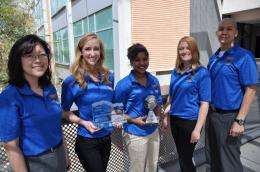Recycled, reusable storm drain filter

(Phys.org) -- A team of students from the University of California, Riverside Bourns College of Engineering won the top prize at an international environmental design competition this month for a reusable storm drain oil filter they designed out of 100 percent recycled materials.
The team, which calls itself “Sustain-a-Drain,” won the open task competition and the 2012 Intel Environmental Innovation Award, the top award at the WERC: A Consortium for Environmental Education and Technology Development in Las Cruces, N.M. It’s run by the Institute for Energy & the Environment (IEE).
On the advice of the judges, the students – Sarah Bates, Elizabeth Hortsman, Thomas Alan Kwan and Shanin Quazi – are planning to patent the product. Similar products exist, but none are made of recycled materials and reusable and none include an indicator that tells the user when to clean it. Also, Sustain-a-Drain’s product and maintenance package is less expensive.
Many industries and business, ranging from automobile maintenance shops to food processing sites, are required to obtain a storm water permit and implement control measures to prevent contaminated runoff from entering storm drains. Those regulations are evolving and expected to become more stringent in the near future.
Inserts are often placed into storm drains to filter oil carried in storm water runoff. However, existing inserts generate a lot of waste with spent filters and it’s difficult to determine if the filter has reached the end of its life.
Sustain-a-Drain has developed an indicator to change that. It’s a plastic test tube-like device with wire mesh and a white polymer powder in the center. The powder turns solid when the filter needs to be cleaned or, if using non-reusable filters, replaced. The indicator hooks on a storm grate, allowing workers to inspect it without having to remove the filter or grate.
The filter, comprised of material used to soak up oil during the 2010 Gulf of Mexico oil spill, is made of 100 percent recycled textiles and looks and feels like a gray felt. It sits in a galvanized steel mesh basket.
The filter material, called Adsorb-it and developed by Eco-Tec, Inc., one of Sustain-a-Drain’s sponsors, “adsorbs” oil, can be wrung, washed and reused. Testing by the U.S. military showed its performance didn’t diminish after 25 cycles. Sustain-a-Drain also plans to work with a company in Van Nuys that would separate the oil from other contaminants and recycle it.
The students – who are advised by Kawai Tam, a lecturer at the Bourns College of Engineering – are all seniors who will be attending graduate school this fall.
Bates, who is originally from England and was a designer for an architecture firm and IKEA before enrolling at UC Riverside, and Kwan, who is originally from Albuquerque, N.M. and previously worked as sound engineer and tour manager for bands, will be going to Yale University.
Hortsman is from Palmdale and will be attending the University of Illinois at Urbana-Champaign. Quazi, a graduate of Poly High School in Riverside, will be going to Stanford University.
Kwan came up with the idea for Sustain-a-Drain while interning during the summer of 2011 with the U.S. Environmental Protection Agency.
He was on a storm water pollution prevention inspection when he realized figuring out when it was time to replace the storm drain filter was fairly subjective.
Kwan, Bates, Hortsman and Quazi set out to change that.
After finding the filter material and creating the indicator, the team tested the filter in a storm drain at UC Riverside’s corporation yard, where about 500 campus vehicles are maintained.
Testing revealed the filter held up to 2.2 times its weight in oil. Also, when they tested a variety of oil and water mixtures virtually no oil passed through the filter.
The students also did an economic analysis that showed their product and the cost of the maintenance it requires is between $30 and $350 less per year than packages offered by companies providing similar services.
In the next week, the students plan to permanently install filters on two storm drains at the corporation yard, one near the vehicle maintenance bays and other near the fueling island.
Amanda Grey, the environmental programs manager at UC Riverside, and Ali Sarkarati, the fleet services manager, are excited that the students are installing the filters, especially considering it was recommended during a recent inspection.
Provided by University of California, Riverside











.jpg)




